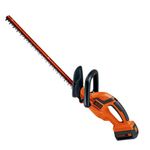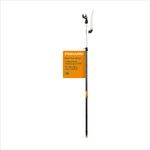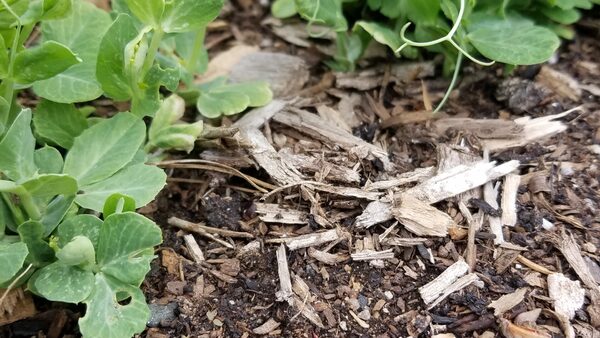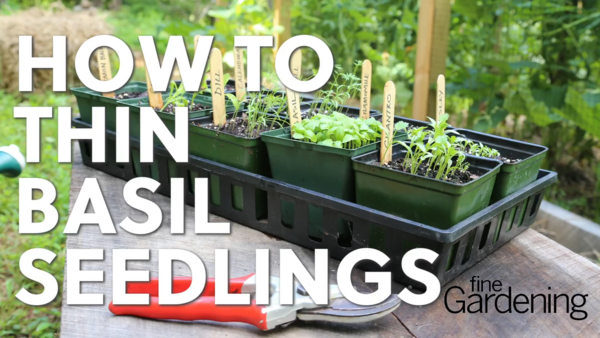
While a light hand is apropos for many pruning jobs, sometimes a judicious but heavy hand is needed. Rejuvenation pruning is a heavy-handed but efficient method to bring overlooked, overgrown, and mismanaged shrubs back to their full potential. It is performed by removing every branch at or a few inches above ground level with a sturdy hand saw, loppers, or even a small chainsaw. For many shrubs in Mid-Atlantic gardens, winter is the perfect time to perform rejuvenation pruning. This is because in our zonal range, most woody plants are dormant and therefore exposed cuts are less likely to become pathways for pests and diseases (which are also dormant). And, when spring weather finally arrives, the shrubs will be perfectly poised to push new, healthy growth.
Rejuvenation pruning tames vigorous growers that have gotten out of hand
A vigorous, healthy shrub that has become overgrown, has lost its distinctive shape or form, or has an excessive number of dead stems from overcrowding will be the best candidate for rejuvenation pruning. This technique can also be a good fix for shrubs that do not flower or fruit to their full potential because individual stems are too weak or immature to produce viable flower buds.

Multistem shrubs that generate new growth from their root systems or from the bases of stems are the best candidates for rejuvenation pruning.
Here are just a few of the shrubs that will tolerate rejuvenation pruning:
- Ninebarks (Physocarpus spp. and cvs., Zones 3–9)
- Bush honeysuckles (Diervilla spp. and cvs., Zones 3–8)
- Viburnums (Viburnum spp. and cvs., Zones 2–9)
- Spireas (Spiraea spp. and cvs., Zones 4–9)
- Willows (Salix spp. and cvs., Zones 4–9)
- Forsythias (Forsythia spp. and cvs., Zones 3–9)
- Deutzias (Deutzia spp. and cvs, Zones 5–8)
- Hydrangeas (Hydrangea spp. and cvs., Zones 3–9)
- Flowering quince (Chaenomeles spp. and cvs., Zones 5–9)
- Red-twig or yellow-twig dogwood (Cornus spp. and cvs., Zones 3–9)
- Honeysuckles (Lonicera spp. and cvs., Zones 3–10)
- Beautyberries (Callicarpa spp. and cvs., Zones 5–9)
- Bush clovers (Lespedeza spp. and cvs., Zones: 4–8)
Please note: If a shrub is in poor general health, is showing signs of stress from pests or disease, or if more than half its shoots are dead, it may be too weak to recover from a complete cutback and could be killed rather than rejuvenated by this technique.
 |
 |
Proper timing is important
When a shrub is cut to the ground, it must rely on reserves stored its roots to stimulate dormant or latent buds for regrowth. Therefore, rejuvenation pruning is best performed when the plant is fully dormant and most of its nutrient reserves from the past growing season are stored in its root system. In the Mid-Atlantic region, January to early March is the ideal time for a heavy cutback. Red-twig and yellow-twig dogwoods, which are excellent for holiday decorating, may be pruned a bit earlier in winter. Dogwoods and willows grown for their vibrant stem colors will benefit from rejuvenation pruning every 3 to 5 years to replace drab older growth with a bright new crop of stems.
Tip: Bring cut stems of flowering quince or forsythia indoors and place them in warm water to trick the dormant flower buds on old growth into producing a few out-of-season blooms.

Post-pruning care will help the shrub recover
Aggressive pruning does cause stress to the plant. After cutting a shrub back, you can aid the process of regrowth by mulching around the base of the plant with well-composted organic matter. Providing adequate moisture and an appropriate fertilizer will also maximize regrowth. Choose fertilizers approved for organic use or bio stimulants that support overall soil health and aid in the process of nutrient cycling.
Mustering the courage to try this technique may take a little faith, but if rejuvenation pruning is done in a thoughtful manner you will be rewarded with a more vibrant and attractive specimen in a few short growing seasons.
Learn more about pruning
A fun take on simplifying the pruning process
For a comprehensive collection of pruning articles from the Fine Gardening archives, check out this great project guide
—Adam Glas is a garden supervisor and rosarian at the Scott Arboretum of Swarthmore College in Swarthmore, Pennsylvania.
All photos: Adam Glas
Fine Gardening Recommended Products

Black & Decker 40-Volt Cordless Hedge Trimmer
Fine Gardening receives a commission for items purchased through links on this site, including Amazon Associates and other affiliate advertising programs.

Fiskars 7.9-12ft Extendable 2-in-1 Pole Tree Trimmer & Pruner with Rotating Head and Precision-Ground Steel Saw Blade
Fine Gardening receives a commission for items purchased through links on this site, including Amazon Associates and other affiliate advertising programs.

isYoung Birdlook® Smart Bird Feeder with Camera
Fine Gardening receives a commission for items purchased through links on this site, including Amazon Associates and other affiliate advertising programs.






















Comments
Log in or create an account to post a comment.
Sign up Log in